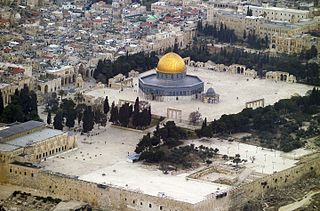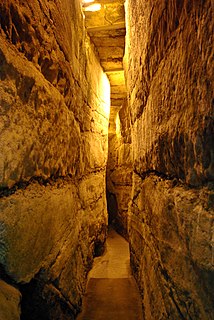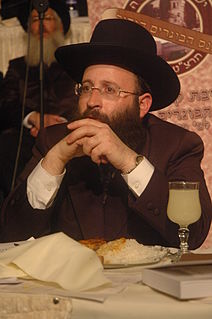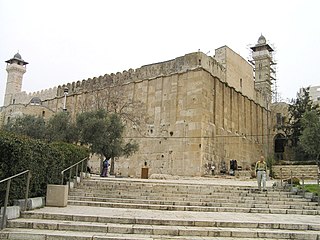
The Temple Mount, known to Muslims as the Haram esh-Sharif and the Al Aqsa Compound, is a hill in the Old City of Jerusalem that for thousands of years has been venerated as a holy site in Judaism, Christianity, and Islam alike.
The City of David is an historic name given to the location of Jerusalem's earliest settlement, believed to have been situated on the Southeast Hill of contemporary Jerusalem. The site was formerly the royal city of King David, from whom it takes its name, and is a place holy unto Jews, Christians and Muslims.

The Wailing Wall or Western Wall, known in Islam as the Buraq Wall, is an ancient limestone wall in the Old City of Jerusalem. It is a relatively small segment of a far longer ancient retaining wall, known also in its entirety as the "Western Wall". The wall was originally erected as part of the expansion of the Second Jewish Temple begun by Herod the Great, which resulted in the encasement of the natural, steep hill known to Jews and Christians as the Temple Mount, in a huge rectangular structure topped by a flat platform, thus creating more space for the Temple itself, its auxiliary buildings, and crowds of worshipers and visitors.

The Old City is a 0.9-square-kilometre (0.35 sq mi) walled area within the modern city of Jerusalem.

During its long history, Jerusalem has been attacked 52 times, captured and recaptured 44 times, besieged 23 times, and destroyed twice. The oldest part of the city was settled in the 4th millennium BCE, making Jerusalem one of the oldest cities in the world.

Mount Zion is a hill in Jerusalem, located just outside the walls of the Old City. The term Mount Zion has been used in the Hebrew Bible first for the City of David and later for the Temple Mount, but its meaning has shifted and it is now used as the name of ancient Jerusalem's Western Hill. In a wider sense, the term is also used for the entire Land of Israel.
The Third Temple is used in reference to a hypothetical rebuilt third Temple in Jerusalem, which would succeed both the original Solomon's Temple and the Second Temple. Although it remains unbuilt, the notion of and desire for a Third Temple in Jerusalem is sacred in Judaism, particularly Orthodox Judaism, and is anticipated as a place of worship. The prophets in the Hebrew Bible called for its construction to be fulfilled prior to, or in tandem with, the Messianic Age. The rebuilding of a Third Temple also plays a major role in some interpretations of Christian eschatology.

The Muslim Quarter is one of the four quarters of the ancient, walled Old City of Jerusalem. It covers 31 hectares of the northeastern sector of the Old City. The quarter is the largest and most populous and extends from the Lions' Gate in the east, along the northern wall of the Temple Mount in the south, to the Damascus Gate—Western Wall route in the west. The Via Dolorosa starts in the quarter.

The Western Wall Tunnel is a tunnel exposing the Western Wall from where the traditional, open-air prayer site ends and up to the Wall's northern end. Most of the tunnel is in continuation of the open-air Western Wall and is located under buildings of the Muslim Quarter of the Old City of Jerusalem. While the open-air portion of the Western Wall is approximately 60 metres (200 ft) long, the majority of its original length of 488 metres (1,601 ft) is hidden underground. The tunnel allows access to the remainder of the Wall in a northerly direction.

Jaffa Road is one of the longest and oldest major streets in Jerusalem. It crosses the city from east to west, from the Old City walls to downtown Jerusalem, the western portal of Jerusalem and the Jerusalem-Tel Aviv highway. It is lined with shops, businesses, and restaurants. It joins with Ben Yehuda Street and King George Street to form the Downtown Triangle central business district. Major landmarks along Jaffa Road are Tzahal Square, Safra Square, Zion Square, Davidka Square, the triple intersection (Hameshulash) at King George V Street and Straus Street, the Ben Yehuda Street pedestrian mall, the Mahane Yehuda market, and the Jerusalem Central Bus Station. Jaffa Road has been redeveloped as a car-free pedestrian mall served by the Jerusalem Light Rail.

The Little Western Wall, also known as HaKotel HaKatan, the Small Kotel,, and the Kleiner Koisel is a Jewish religious site located in the Muslim Quarter of the Old City of Jerusalem near the Iron Gate to the Temple Mount. The wall itself dates from the Second Temple period,. It is the continuation of the larger part of the Western Wall and almost exactly faces the Holy of Holies. HaKotel HaKatan is not as well-known and not as crowded as the larger part of the Western Wall. This section of the wall is of deep spiritual significance because of its close proximity to the Holy of Holies. However, it is not the closest location to the Holy of Holies, as there is a location in the Western Wall Tunnel which directly faces the Holy of Holies.

The Tel Aviv–Jerusalem railway is a railway line connecting the cities of Tel Aviv and Jerusalem in Israel. The line serves as the main rail link between Tel Aviv and Jerusalem, complementing the old Jaffa–Jerusalem railway. As such, the railway is often referred to in Israel as the high-speed railway to Jerusalem to distinguish it from the older, longer and slower line. In spite of that name, the line is not high-speed under the definition used by the International Union of Railways: its design speed of 160 km/h (99 mph) is below the 250 km/h (160 mph) threshold used by the UIC to define high-speed railways, and it is traversed by IR's regular rolling stock instead of the UIC requirement for specially-designed high-speed trains.

Shmuel Rabinovitch, also spelled Rabinowitz is an Orthodox rabbi and Rabbi of the Western Wall and the Holy Sites of Israel. In his duties as Rabbi of the Wall in the Old City of Jerusalem, Rabbi Rabinovich maintains the historic traditional Jewish practices of the Wall as a site of orthodox Jewish prayer and ensures that notes placed in the Wall are removed and treated consistent with tradition and halakhah. He escorts visiting heads of state and foreign dignitaries during visits to the Wall, and has published on the Jewish laws and customs of the Western Wall.

Herodian architecture is a style of classical architecture characteristic of the numerous building projects undertaken during the reign of Herod the Great, the Roman client king of Judea. Herod undertook many colossal building projects, most famously his reconstruction of the Temple in Jerusalem. Many of his structures were built upon comparable, previous Hasmonean buildings and most of his have, in their turn, vanished as well.

A number of archaeological excavations at the Temple Mount—a celebrated and contentious religious site in the Old City of Jerusalem—have taken place over the last 150 years. Excavations in the area represent one of the more sensitive areas of all archaeological excavations in Jerusalem.

Jerusalem during the Second Temple period describes the history of the city from the return to Zion under Cyrus the Great to the 70 CE siege of Jerusalem by Titus during the First Jewish–Roman War, which saw both region and city change hands several times. It was the center of religious life for all Jews; even those who lived in the diaspora prayed towards Jerusalem on a daily basis and made pilgrimages during religious festivals. The Pharisees of Second Temple Judaism developed into the Tannaim and Judaism's post-Exilic religious identity as it continues today, and the Hebrew Bible was perhaps canonized, although exactly when this occurred remains disputed. It was also in Jerusalem during the later stages of this period that Christianity was born.

Robinson's Arch is the name given to a monumental staircase carried by an unusually wide stone arch, which once stood at the southwestern corner of the Temple Mount. It was built as part of the expansion of the Second Temple initiated by Herod the Great at the end of the 1st century BCE. Recent findings suggest that it may not have been completed until at least 20 years after his death. The massive stone span was constructed along with the retaining walls of the Temple Mount. It carried traffic up from ancient Jerusalem's Lower Market area and over the Tyropoeon street to the Royal Stoa complex on the esplanade of the Mount. The overpass was destroyed during the First Jewish–Roman War, only a few decades after its completion.

The Struthion Pool, effectually translated from the Greek as 'Sparrow Pool' is a large cuboid cistern beneath the Convent of the Sisters of Zion in the Old City of Jerusalem, built by Herod the Great in the first century BCE.

Wilson's Arch is the modern name for an ancient stone arch from Jerusalem, the first in a row of arches that supported a large bridge connecting the Herodian Temple Mount with the Upper City on the opposite Western Hill. The Arch springs from the Western Wall and is still visible underneath later buildings set against the Wall. The name Wilson's Arch is also used to denote the hall that it partially covers, which is currently used as a synagogue. This hall opens towards the Western Wall Plaza at the Plaza's northeast corner, so that it appears on the left of the prayer section of the Western Wall to visitors facing the Wall.

City of David (Silwan) is the Wadi Hilweh area of the Palestinian Arab village of Silwan intertwined with an Israeli settlement, The Silwan area of East Jerusalem was annexed by Israel following the 1967 Six-Day War and 1980 Jerusalem Law, an action not recognized internationally. The international community regards Israeli settlements as illegal under international law, although Israel disputes this.

















